Google and Apple have achieved great success in the past two years. Facebook and Microsoft will also follow a suit. You may wonder- which success we are talking about? Well, this achievement is about renewable-powered operations. Thanks to the green data center concept, both these software giants have achieved 100% renewable-powered operations two years back. Isn’t it interesting to discuss the future and opportunities of data centers in today’s data-driven world?
The significance of the green data center will only increase in the coming time because they store, communicate, and transmit all necessary information we produce daily. It is certain that we are going to generate more data in the future, which will make the data center’s role more vital than ever. As per one estimate, we will produce over 175 zettabytes of data by 2025. Data centers will help us compute, store, and manage this massive amount of data.
Future of Data CentersFrom smaller and more distributed data centers to larger and more centralized data centers- the future of data centers seems vivid and diverse in line with complex business needs. While considering the design, location, structure, and capacity of data centers, we need to count its role in curbing global emissions as well. Though data centers consume 2 to 3% of the total electricity of the world, the growing demand can increase this usage significantly. As per another estimate, the electricity consumption from data centers would jump to as much as 13% by 2030.
Here, green data center services can lend a helping hand. Sectors like manufacturing, real estate, and transportation generate a pile of data on a daily basis, and they can shift to green data centers to reduce their emissions. For example, an automobile maker can outsource its in-house computing system to zero-emission data centers for saving electricity and reducing emissions. The data centers rely on cloud computing technology and renewable sources.
Also Read- Role of Green Data Centers in Promoting Green TechnologyToday, we witness a steady rise in the prevalence of emerging technologies like AI, ML, big data, and IoT (Internet of Things). This will contribute to the future of climate and data centers alike. Green data centers need to remain more energy-efficient in the future for strengthening climate change mitigation efforts. It is fair to mention that green data centers will remain in focus on achieving the target of net zero emissions by 2050. Intergovernmental Panel on Climate Change (IPCC) has recommended this goal.
Types of Data Centers for FutureEdge Data Centers
As mentioned above, small and distributed data centers are called edge data centers. They provide hyper-local storage and processing capacity at the edge of the network. Though cloud computing is a reliable and cost-effective way to connect devices to the internet, the continuous growth of IoT and other futuristic technologies has put a strain on the network bandwidth. Edge computing is considered as an alternative to cloud computing to address bandwidth issues.
Still, edge computing is in the nascent stage, it has shown the potential by providing a more efficient data processing method for numerous use cases. Tesla cars’ powerful onboard computers work on this concept. Companies like EdgeMicro, Schneider Electric, and Huawei are top players in providing edge data centers.
Mega Data CentersThey are in contrast to edge data centers. Mega data centers have at least 1M square feet of data center space to meet the data needs of tens of thousands of companies at once. It offers a great benefit thanks to a larger scale. Though these mega data centers are highly expensive to build, they offer more cost per square foot than the same for an average data center. Switch Communications has built a 17.4M square foot capacity, which is one of the largest mega data center projects. It provides cooling, power, bandwidth, and physical security to the corporate servers. Facebook is also building a 2.5M square foot data center in Fort Worth, Texas for storing and processing zillions of data containing personal user information.
Other Innovative ConceptsThese days, many companies are experimenting with data centers. Some of them build data centers that can be operated in or on the ocean. Microsoft’s Project Natick is one of the most happening examples of this innovative concept. This submerged Datacenter is designed to cool the servers at low cost by using the ocean on the coast of Scotland.
In the future, data centers will reduce emissions by following these two ways- One, by making energy usage inside a data center more efficient and two, ensure the usage of clean and renewable energy.
Focus on Energy EfficiencyIt all started in 2016 when Google and DeepMind have worked on an AI-based system to make Google’s data centers more energy-efficient. Even small changes could bring significant energy saving by reducing emissions. However, once the recommendations were given, it was quite a task to implement them. No AI system is capable to control a data center’s cooling and heating process to date as per Google. Currently, Google’s AI control system focuses on constraints that put safety and reliability on priority. This system delivers 30% of energy savings on average.

Image Source: Deepmind.com
A typical day of PUE (power usage effectiveness) with ML turned on and off.
In the coming time, the focus will remain on cooling and heating processes because they are responsible for energy consumption. Also, data storage devices like SSD (Solid State Devices), CDs and magnetic tapes will get more powerful over the period to provide greater storage capacity per unit.
Concluding LinesThe future and growth opportunities for green data centers depend on three-point criteria. First, the data center should have 1.2 or less PUE (Power Usage Effectiveness) rating. Two, the data center must be powered by 100% renewable sources, and three, any electric grid power used by the data center produces a minuscule amount of CO2 emissions. (0.19 kg /kWh of IT energy consumption). By following these criteria, the data center of the future will significantly reduce emissions and save energy.
Silver Touch Technologies is a VMware and Microsoft Gold-certified partner for providing server virtualization solutions globally. Contact us at info@silvertouch.com for leveraging the benefits of secure and scalable green data centers and cloud-based virtual solutions.


